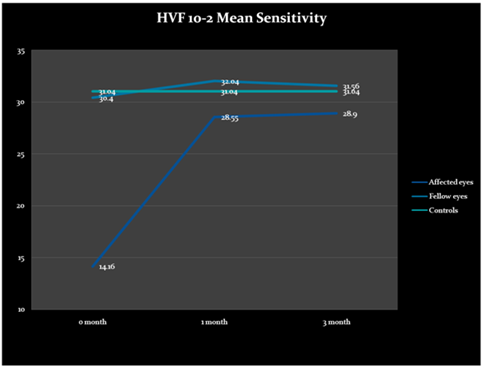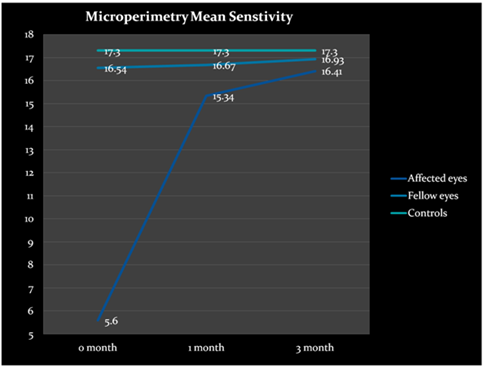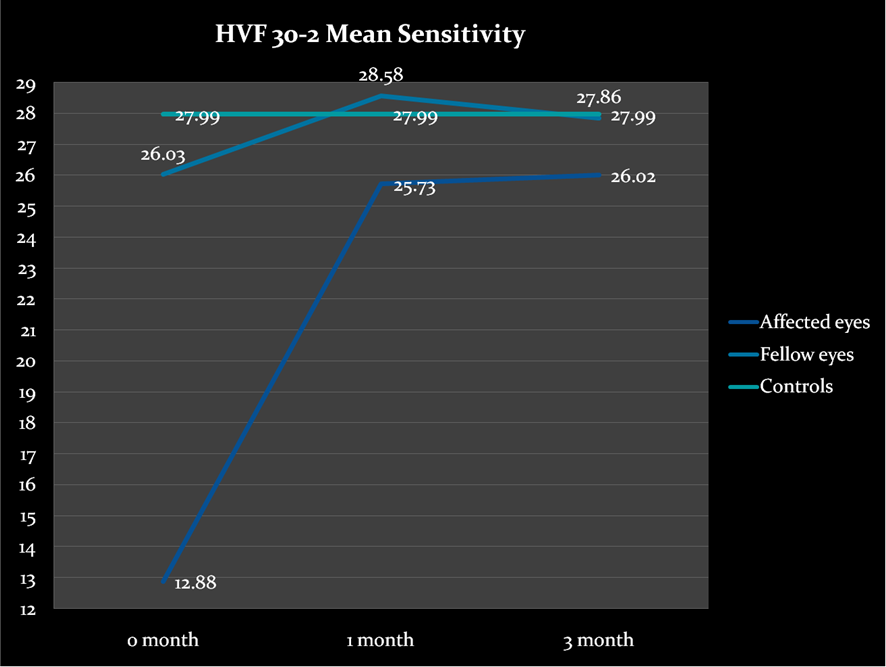1. Nevalainen J, Krapp E, Paetzold J, et al. Visual field defects in acute optic neuritis–distribution of different types of defect pattern, assessed with threshold-related supraliminal perimetry, ensuring high spatial resolution. Graefes Arch Clin Exp Ophthalmol. 2008; 246(4): 599-607. doi: 10.1007/s00417-007-0722-2
2. Keltner JL, Johnson CA, Spurr JO, Beck RW. Baseline visual field profile of optic neuritis the experience of the optic neuritis treatment trial. Arch Ophthalmol. 1993; 111(2): 231-234. doi: 10.1001/archopht.1993.01090020085029
3. Fang JP, Donahue SP, Lin RH. Global visual field involvement in acute unilateral optic neuritis. Am J Ophthal. 1999; 125(5): 554-565. doi: 10.1016/S0002-9394(99)00298-6
4. Keltner JL, Johnson CA, Spurr JO, Beck RW. Comparison of central and peripheral visual field properties in the optic neuritis treatment trial. Am J Ophthalmol. 1999; 128(5): 543-553. doi: 10.1016/S0002-9394(99)00304-9
5. Rothová Z, Jech R. Residual findings in retrobulbar neuritis during demyelinization. Cesk Slov Oftalmol. 1998; 54(2): 95-99. Web site. http://europepmc.org/abstract/med/9622948. Accessed June 29, 2016
6. Gerling J, Meyer JH, Kommerell G. Visual field defects in optic neuritis and anterior ischemic optic neuropathy: Distinctive features. Graefes Arch Clin Exp Ophthalmol. 1998; 236(3): 188-192. doi: 10.1007/s004170050062
7. Trobe JD, Glaser JS. Quantitative perimetry in compressive optic neuropathy and optic neuritis. Arch Ophthalmol. 1978; 96(7): 1210-1216. doi: 10.1001/archopht.1978.03910060044008
8. Beck RW, Kupersmith MJ, Cleary PA, Katz B. Fellow eye abnormalities in acute unilateral optic neuritis: Experience of the optic neuritis treatment trial. Ophthalmology. 1993; 100(5): 691-697. doi: 10.1016/S0161-6420(13)31589-9
9. Orzalesi N, Miglior S, Lonati C, Rosetti L. Microperimetry of localized retinal nerve fiber layer defects. Vision Res. 1998; 38(5): 763-771. doi: 10.1016/S0042-6989(97)00171-5
10. Van de Velde FJ, Timberlake GT, Jalkh AE, Schepens CL. Static microperimetry with the laser scanning ophthalmoscope. (In French) Ophtalmologie. 1990; 4(3): 291-294. Web site. http://www.ncbi.nlm.nih.gov/pubmed/2250964. Accessed June 29, 2016
11. Jean B, Frohn A, Thiel HJ. Laser scanning in ophthalmology. Fortschr Ophthalmol. 1990; 87(2): 158-167. Web site. http://europepmc.org/abstract/med/2192974. Accessed June 29, 2016
12. Sjaarda RN, Frank DA, Glaser BM, Thompson JT, Murphy RP. Resolution of an absolute scotoma and improvement of relative scotomata after successful macular hole surgery. Am J Ophthalmol. 1993; 116(2): 129-139. doi: 10.1016/S0002-9394(14)71276-0
13. Schneider U, Kuck H, Inhoffen W, Kreissig I. Fundus-controlled microperimetry with the scanning laser ophthalmoscope in macular diseases. Klin Monbl Augenheilkd. 1993; 203(3): 212-218. doi: 10.1055/s-2008-1045670
14. Sjaarda RN, Frank DA, Glaser BM, Thompson JT, Murphy RP. Assessment of vision in idiopathic macular holes with macular microperimetry using the scanning laser ophthalmoscope. Ophthalmology. 1993; 100(10): 1513-1518. doi: 10.1016/S0161-6420(93)31448-X
15. Kakehashi A, Ishiko S, Konno S, Akiba J, Yoshida A. Differential diagnosis of macular breaks by microperimetry with a scanning laser ophthalmoscope. Nippon Ganka Gakkai Zasshi. 1995; 99(8): 920-924. Web site. http://europepmc.org/abstract/med/7676892. Accessed June 29, 2016
16. Toonen F, Remky A, Janssen V, Wolf S, Reim M. Microperimetry in patients with central serous retinopathy. Ger J Ophthalmol. 1995; 4(5): 311-314. Web site. http://europepmc.org/abstract/med/7496344. Accessed June 29, 2016
17. Schneider U, Kuck H, Inhoffen W, Kreissig I. Fundus oriented microperimetry with the scanning laser ophthalmoscope in age-induced macular degeneration. Klin Monbl Augenheilkd. 1996; 209(2-3): 8-13. Web site. http://europepmc.org/abstract/med/8992088. Accessed June 29, 2016
18. Schneider U, Inhoffen W, Gelisken F, Kreissig I. Assessment of visual function in choroidal neovascularization with scanning laser microperimetry and simultaneous indocyanine green angiography. Graefes Arch Clin Exp Ophthalmol. 1996; 234(10): 612-617. doi: 10.1007/BF00185293
19. Tezel TH, Del Priore LV, Flowers BE, et al. Correlation between scanning laser ophthalmoscope microperimetry and anatomic abnormalities in patients with subfoveal neovascularization. Ophthalmology. 1996; 103(11): 1829-1836. doi: 10.1016/S0161-6420(96)30419-3
20. Tsujikawa M, Ohji M, Fujikado T, Saito Y, Motokura M, Ishimoto I, Tano Y. Differentiating full thickness macular holes from impending macular holes and macular pseudoholes. Br J Ophthalmol. 1997; 81(2): 117-122. doi: 10.1136/bjo.81.2.117
21. Ishiko S, Ogasawara H, Yoshida A, Hanada K. The use of scanning laser ophthalmoscope microperimetry to detect visual impairment caused by macular photocoagulation. Ophthalmic Surg Lasers. 1998; 29(2): 95-98. doi: 10.3928/1542-8877-19980201-03
22. Takamine Y, Shiraki K, Moriwaki M, Yasunari T, Miki T. Retinal sensitivity measurement over drusen using scanning laser ophthalmoscope microperimetry. Graefes Arch Clin Exp Ophthalmol. 1998; 236(4): 285-290. doi: 10.1007/s004170050079
23. Lima VC, Prata TS, De Moraes CGV, et al. A comparison between microperimetry and standard achromatic perimetry of the central visual field in eyes with glaucomatous paracentral visual-field defects. Br J Ophthalmol. 2010; 94(1): 64-67. doi: 10.1136/bjo.2009.159772
24. Romano MR, Angi M, Romano F. Macular sensitivity change in multiple sclerosis followed with microperimetry. Eur J Ophthalmol. 2007; 17(3): 441-444. Web site. http://medlib.yu.ac.kr/eur_j_oph/ejo_pdf/2007_17_441-444.pdf. Accessed June 29, 2016
25. Xiao-Peng Cao, Yun Xiao, Xiao-Wei Gao, Xue-Hong Cai, Ying Lei, Peng Cao. Clinical effect of MP-1 microperimetry detection in early diagnosis of acute retrobulbar neuritis; (In Chinese). International Eye Science. 2012.
26. Acton JH, Greenstein VC. Fundus-driven perimetry (microperimetry) compared to conventional static automated perimetry: similarities, differences and clinical applications. Can J Ophthalmol. 2013; 48(5): 358-363. doi: 10.1016/j.jcjo.2013.03.021
27. Trobe JD, Beck RW, Moke PS, Cleary PA. Contrast sensitivity and other vision tests in the optic neuritis treatment trial. Am J Ophthalmol. 1996; 121: 547-553. doi: 10.1016/S0002-9394(14)75429-7
28. Beck RW, Cleary PA. Optic neuritis treatment trial: One-year follow-up results. Arch Ophthalmol. 1993; 111(6): 773-775. doi: 10.1001/archopht.1993.01090060061023
29. Beck RW, Trobe JD. The optic neuritis treatment trial: Putting the results in perspective. J Neuro-ophthalmol. 1995; 15: 131-135. Web site. http://www.ncbi.nlm.nih.gov/pubmed/8574355. Accessed Accessed June 29.
30. Mienberg O, Flammer J, Ludin HP. Subclinical visual field defects in multiple sclerosis: Demonstration and quantification with automated perimetry, and comparison with visually evoked potentials. J Neurol. 1982; 227(3): 125-133. doi: 10.1007/BF00313566








